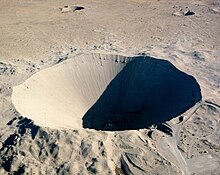
Back مشروع بلوشير Arabic Operation Plowshare German Operación Plowshare Spanish Operaatio Plowshare Finnish Opération Plowshare French Operazione Plowshare Italian 보습 기획 Korean Operacja Plowshare Polish Programa Plowshare Portuguese Операция «Плаушер» Russian

Project Plowshare was the overall United States program for the development of techniques to use nuclear explosives for peaceful construction purposes. The program was organized in June 1957 as part of the worldwide Atoms for Peace efforts. As part of the program, 35[1] nuclear warheads were detonated in 27 separate tests. A similar program was carried out in the Soviet Union under the name Nuclear Explosions for the National Economy.
Successful demonstrations of non-combat uses for nuclear explosives include rock blasting, stimulation of tight gas, chemical element manufacture,[a] unlocking some of the mysteries of the R-process of stellar nucleosynthesis and probing the composition of the Earth's deep crust, creating reflection seismology vibroseis data which has helped geologists and follow-on mining company prospecting.[2][3][4]
The project's uncharacteristically large and atmospherically vented Sedan nuclear test also led geologists to determine that Barringer crater was formed as a result of a meteor impact and not from a volcanic eruption, as had earlier been assumed. This became the first crater on Earth definitely proven to be from an impact event.[5]
Negative impacts from Project Plowshare's tests generated significant public opposition, which eventually led to the program's termination in 1977.[6] These consequences included tritiated water (projected to increase by CER Geonuclear Corporation to a level of 2% of the then-maximum level for drinking water)[7] and the deposition of fallout from radioactive material being injected into the atmosphere before underground testing was mandated by treaty.
- ^ Weinersmith, Zach (2017). 10 Emerging Technologies That'll Improve and/or ruin everything. p. 154. ISBN 978-0399563829.
- ^ Cite error: The named reference
Executive Summarywas invoked but never defined (see the help page). - ^ "Archived copy". www.ociw.edu. Archived from the original on February 10, 2006. Retrieved January 12, 2022.
{{cite web}}: CS1 maint: archived copy as title (link) - ^ "Carnegie Observatories Astrophysics Series". February 10, 2006. Archived from the original on February 10, 2006.
- ^ "Keyah Math – Numerical Solutions for Culturally Diverse Geology". keyah.asu.edu.
- ^ Cite error: The named reference
bks2011was invoked but never defined (see the help page). - ^ Jacobsen, Sally (May 1972). "Turning up the Gas: AEC Prepares Another Nuclear Gas Stimulation Shot". Bulletin of the Atomic Scientists. 28 (5): 37. doi:10.1080/00963402.1972.11457935. ISSN 0096-3402.
Cite error: There are <ref group=lower-alpha> tags or {{efn}} templates on this page, but the references will not show without a {{reflist|group=lower-alpha}} template or {{notelist}} template (see the help page).
© MMXXIII Rich X Search. We shall prevail. All rights reserved. Rich X Search